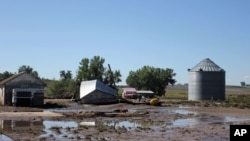DENVER —
Colorado farmers and ranchers are bracing for widespread damage to the agriculture industry, one of the state's leading economic engines, from deadly floodwaters that already have caused property losses estimated at nearly $2 billion.
The main concern is for the state's No. 1 cash crop, corn, which yields between 140 million and 180 million bushels annually, most of it for cattle feed, according to the growers' trade association, Colorado Corn.
Cornfields along the flooded South Platte River could be lost if water that has swamped low-lying prairie fails to drain away before the October harvest, said Brent Boydston, vice president of public policy for the Colorado Farm Bureau.
“The corn will rot... if it's underwater that long,” Boydston said, adding that waterlogged hay crops could become moldy and be ruined as well.
Agriculture pumps $41 billion a year into the state's economy and employs - directly or indirectly - 173,000 people, according to the Colorado Department of Agriculture.
Cash from Colorado farm receipts alone totals $7.1 billion annually.
Ron Ackerman, whose family harvests hay in La Salle, Colorado, in flood-stricken Weld County, said he fears their fall crop may be a total loss.
“Our hay is standing in the fields covered in mud, and there's so much debris we can't cut it - it could damage our equipment,” he said.
Ackerman, who also does work for corn growers in the area, said the inundation of their fields may destroy entire harvests, especially for silage that must be cut at the right time to be of any value.
Wheat weather
For Colorado wheat growers, the state's second-largest cash crop, the additional moisture is expected to benefit the water-dependent grain.
“Overall, this will have a positive impact,” said Darrell Hanavan, executive director of the Colorado Association of Wheat Growers.
About 25 percent of Colorado's wheat farms lie in the drought-stricken southeastern corner of the state, which has received some of the rain associated with flooding farther to the north but not enough to cause harm, he said.
Farmers in the fertile region of northeastern Colorado face additional challenges if irrigation lines that are their lifeblood end up damaged by flooding, or if they cannot run combines through soaked fields, the farm bureau's Boydston said.
Governor John Hickenlooper said at a news conference on Thursday that irrigation systems in some areas had been largely washed away.
Even if farmers manage to harvest their crops, damage to transportation and other infrastructure could prevent them from getting their produce to market, or hinder ranchers in getting their herds to feedlots, Boydston said.
Terry Fankhauser, executive vice president of the 2,500-member Colorado Cattlemen's Association, said crop damage would also hit livestock producers.
“Many of our ranchers are farmers as well, and the loss of silage and feed for herds could have a significant impact,” he said.
Looking on the bright side, Fankhauser said, the floodwaters will go a long way in replenishing the state's drought-depleted reservoirs.
The main concern is for the state's No. 1 cash crop, corn, which yields between 140 million and 180 million bushels annually, most of it for cattle feed, according to the growers' trade association, Colorado Corn.
Cornfields along the flooded South Platte River could be lost if water that has swamped low-lying prairie fails to drain away before the October harvest, said Brent Boydston, vice president of public policy for the Colorado Farm Bureau.
“The corn will rot... if it's underwater that long,” Boydston said, adding that waterlogged hay crops could become moldy and be ruined as well.
Agriculture pumps $41 billion a year into the state's economy and employs - directly or indirectly - 173,000 people, according to the Colorado Department of Agriculture.
Cash from Colorado farm receipts alone totals $7.1 billion annually.
Ron Ackerman, whose family harvests hay in La Salle, Colorado, in flood-stricken Weld County, said he fears their fall crop may be a total loss.
“Our hay is standing in the fields covered in mud, and there's so much debris we can't cut it - it could damage our equipment,” he said.
Ackerman, who also does work for corn growers in the area, said the inundation of their fields may destroy entire harvests, especially for silage that must be cut at the right time to be of any value.
Wheat weather
For Colorado wheat growers, the state's second-largest cash crop, the additional moisture is expected to benefit the water-dependent grain.
“Overall, this will have a positive impact,” said Darrell Hanavan, executive director of the Colorado Association of Wheat Growers.
About 25 percent of Colorado's wheat farms lie in the drought-stricken southeastern corner of the state, which has received some of the rain associated with flooding farther to the north but not enough to cause harm, he said.
Farmers in the fertile region of northeastern Colorado face additional challenges if irrigation lines that are their lifeblood end up damaged by flooding, or if they cannot run combines through soaked fields, the farm bureau's Boydston said.
Governor John Hickenlooper said at a news conference on Thursday that irrigation systems in some areas had been largely washed away.
Even if farmers manage to harvest their crops, damage to transportation and other infrastructure could prevent them from getting their produce to market, or hinder ranchers in getting their herds to feedlots, Boydston said.
Terry Fankhauser, executive vice president of the 2,500-member Colorado Cattlemen's Association, said crop damage would also hit livestock producers.
“Many of our ranchers are farmers as well, and the loss of silage and feed for herds could have a significant impact,” he said.
Looking on the bright side, Fankhauser said, the floodwaters will go a long way in replenishing the state's drought-depleted reservoirs.











